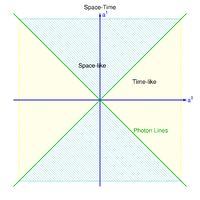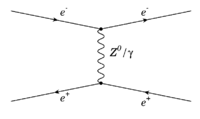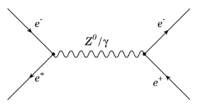Difference between revisions of "Forest Bhabha Scattering"
| Line 80: | Line 80: | ||
:<math>\bar{u}_3 (ig_e\gamma^{\nu} u_4</math> | :<math>\bar{u}_3 (ig_e\gamma^{\nu} u_4</math> | ||
| + | |||
| + | |||
| + | === Matrix amplitude=== | ||
| + | |||
| + | |||
| + | |||
| + | :<math>\cal{M}_t = \bar{u}_2 (ig_e\gamma^{\mu} u_1 \left ( \frac{-ig_{\mu \nu}}{q^2} \right) \bar{u}_3 (ig_e\gamma^{\nu} u_4</math> = t-channel scattering matrix amplitude | ||
==e+e- Annihilation (s-channel) (time-like)== | ==e+e- Annihilation (s-channel) (time-like)== | ||
Revision as of 05:31, 15 April 2012
Bhabha (electron - positron) Scattering
Bhabha scattering identifies the scatterng of an electron and positron (particle and anti-particle). There are two processes that can occur
1.) scattering via the "instantaneous" exchange of a virtual photon
2.) annihilation in which the e+ and e- spend some time as a photon which then reconverts back to an e+e- pair
e+e- scattering (t-channel) (space-like)
The Feynman diagram is a space-time description of the interaction where the horizontal axis (abscissa) is used to denote time and the vertical axis (ordinate) is 3-D space.
A particle which travels only along the horizontal time axis is not moving in space while a particle traveling only along the vertical axis is not moving in time (within the uncertainty principle).
Step 1 Draw the Feynman Diagram
If the electron and positron simply scatter off of one another via a coulomb interaction, then they exchange a photon along the space axis. You start with an external line from the left to represent the electron. This is a "t-channel" process in which one of the particles emits a virtual photon that is absorbed by the other particle. You can tell the exchanged particle is virtual if it is drawn parallel to the time axis in the Feynman diagram.
- The time axis is from left to right so the Virtual particle is along the space axis (in some books the diagram has the space axis horizontal). Also note that a virtual, neutral Z-boson may also be exchanged via the electro-weak interaction.
Step 2 Label 4-Momentum
Let:
- initial electron 4-momentum
- initial electron spinor
- final electron 4-momentum
- final electron spinor
- initial positron 4-momentum
- initial positron spinor
- final positron 4-momentum
- final positron spinor
Momentum conservation at the electron vertex
Conservation of 4-momentum at the electron vertex for the e+e- scattering Feynman diagram
if
Then
- photon with mass Virtural Photon
Step 3 Matrix Element
First Vertex
The electron scatters
photon propogator
Second Vertex
The electron scatters
Matrix amplitude
- = t-channel scattering matrix amplitude
e+e- Annihilation (s-channel) (time-like)
If the electron and positron form an intermediate state which then decays back to an electron and positron. This is a "s-channel" process in which
- Momentum conservation at the first vertex
- In reality the
Step 2 identify 4-Momentum conservation
Let:
- initial electron 4-momentum
- initial electron spinor
- final electron 4-momentum
- final electron spinor
- initial positron 4-momentum
- initial positron spinor
- finial positron 4-momentum
- finial positron spinor
Step 3 Determine Matrix element for each vertex
Step 4 Find total amplitude
Matrix element for scattering
According to the Feynman RUles for QED:
the term
is used at the vertex to describe the Quantum electrodynamic (electromagneticc) interaction between the two fermion spinor states entering the vertex and forming a photon which will "connect" this vertex with the next one.
- The QED interaction Lagrangian is
Matrix element for annihilation
Radiative Bhabha Scattering to measure running of alpha


